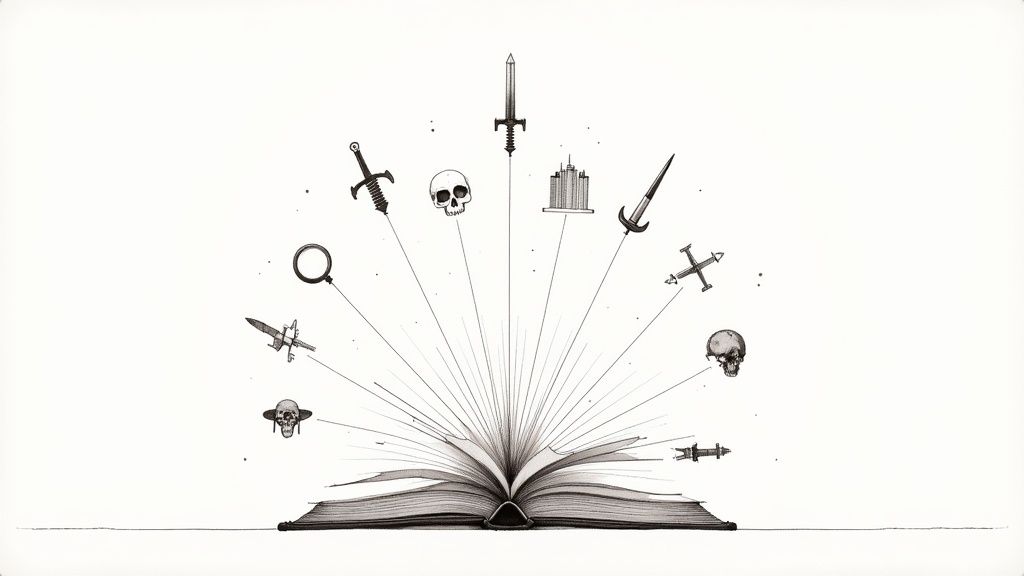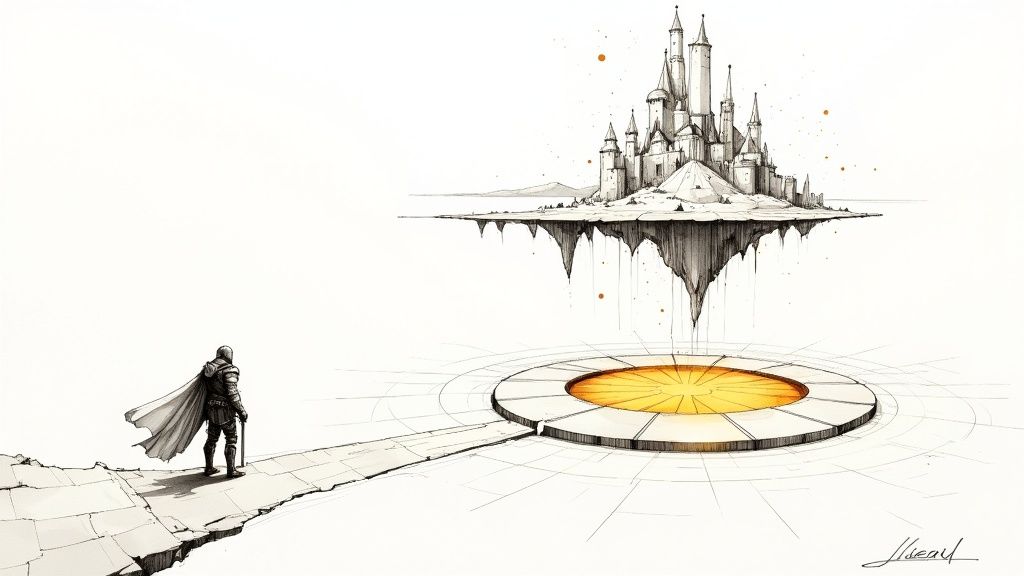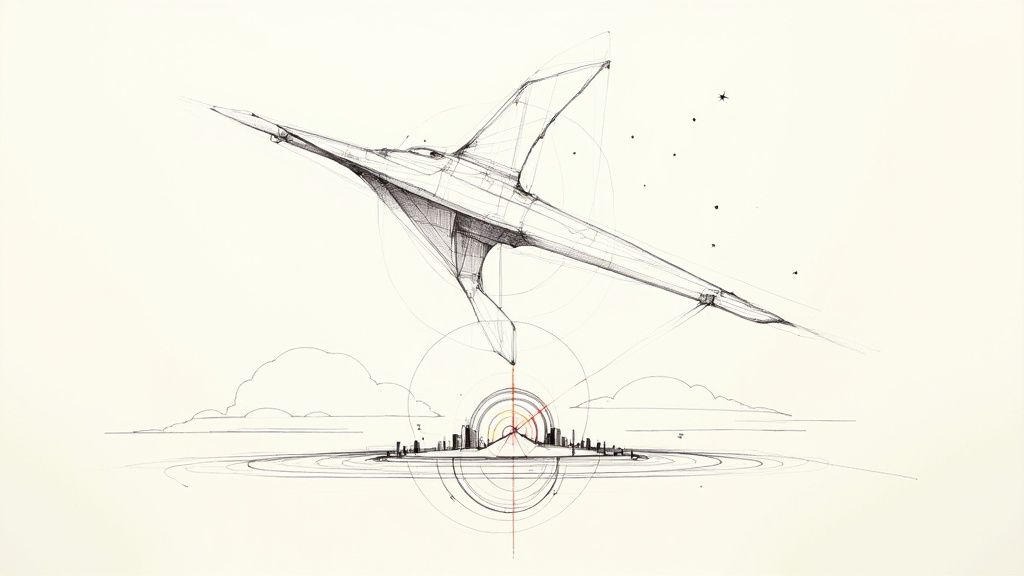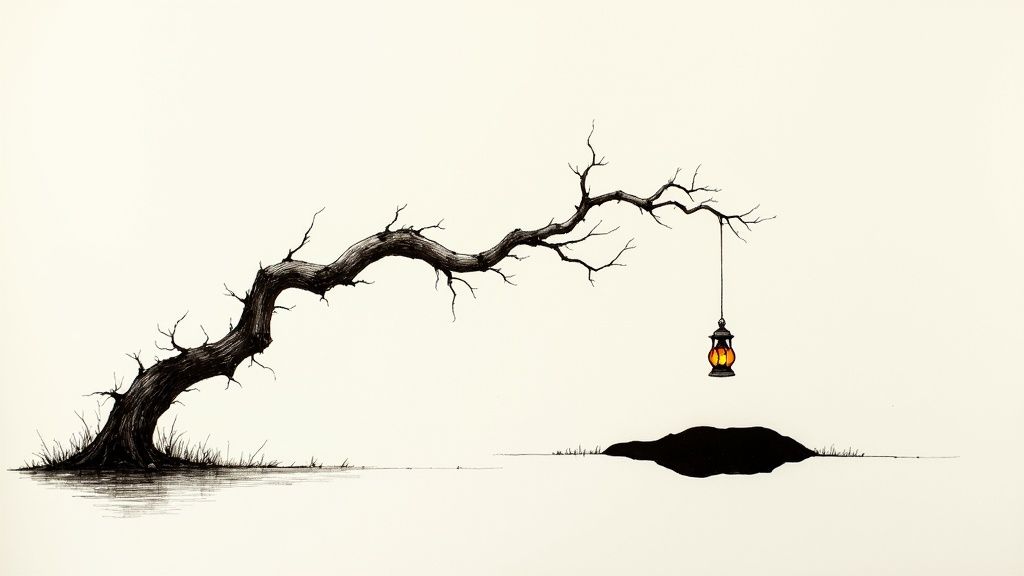A Guide to the 10 Major Types of Fictional Genres for 2025

Welcome, author! You've poured your heart into a manuscript, crafting worlds and characters that live and breathe on the page. Now comes the next crucial step: positioning your book for success. Understanding the vast landscape of types of fictional genres is not just an academic exercise; it is a fundamental marketing tool that directly impacts your novel's discoverability and sales potential.
Knowing precisely where your story fits, whether it's high fantasy, a cozy mystery, or a contemporary romance, is essential. This knowledge empowers you to connect with the right readers, select effective keywords for online retailers, and pitch to agents and publishers with unshakeable confidence. Misidentifying your genre can mean marketing to the wrong audience, leading to poor reviews and missed opportunities. Correctly categorizing your work is the first step toward building a loyal fanbase.
This comprehensive guide is designed to be your roadmap. We will explore 10 major types of fictional genres, breaking down their core conventions, unique subgenres, and illustrative examples. We'll move beyond simple definitions to provide actionable insights that help you clarify your book's identity and sharpen its marketing message. By the end of this article, you will have a clear framework for placing your work within the literary marketplace, ensuring your story finds its perfect home on the reader's bookshelf.
1. Fantasy
Fantasy is one of the most expansive and beloved types of fictional genres, defined by its use of magic, supernatural phenomena, and imaginative worlds that exist outside the bounds of scientific reality. At its core, fantasy invites readers into meticulously crafted "secondary worlds," complete with their own laws of nature, complex magic systems, unique histories, and distinct mythologies. These settings often draw inspiration from medieval Europe but can encompass a vast range of cultural and technological aesthetics. The genre frequently explores timeless themes like the struggle between good and evil, the hero's journey, the corrupting influence of power, and the enduring power of hope and wonder.

This genre has been shaped by literary giants whose works have become cultural cornerstones. J.R.R. Tolkien is often credited as the father of modern fantasy with The Lord of the Rings, which established many of the genre's key tropes. More recently, George R.R. Martin's A Song of Ice and Fire introduced a grittier, more political style known as "grimdark," while J.K. Rowling's Harry Potter series brought fantasy to a new generation by blending the magical with the mundane in an urban fantasy setting.
Key Elements of Fantasy
To build a compelling fantasy narrative, focus on these critical components:
- World-Building: Create a detailed and immersive world. Develop maps, establish political structures, and write histories for your civilizations. A rich setting makes the fantastical elements feel more grounded and believable.
- Magic Systems: Define the rules of your magic. A "hard" magic system has explicit rules and limitations (like in Brandon Sanderson's Mistborn), while a "soft" system is more mysterious and wondrous (as in Tolkien's work). Consistency is key to maintaining reader trust.
- Grounded Characters: Even in a world with dragons and wizards, characters must have relatable human emotions and motivations. Their struggles, fears, and triumphs are what anchor the reader to the story.
When developing your own fantasy project, bringing the world to life visually can be a powerful tool for inspiration and branding. For authors and creators looking to visualize their characters, creatures, or magical items, using an AI sticker generator for Fantasy can provide unique and custom artwork, perfect for character sheets, promotional materials, or simply sparking creativity.
2. Science Fiction
Science Fiction, often called Sci-Fi, is a genre that explores imaginative and futuristic concepts grounded in scientific principles. It delves into advanced technology, space exploration, time travel, parallel universes, and extraterrestrial life, often examining the profound impact of these innovations on human society. At its heart, science fiction is a genre of "what if," using speculative scenarios to explore both utopian possibilities and dystopian warnings. It frequently serves as a powerful lens through which we can analyze contemporary social, political, and ethical issues, all while pushing the boundaries of human knowledge and imagination.

This genre has been shaped by visionaries whose work defined its scope. Isaac Asimov’s Foundation series explored "psychohistory," a fictional science of predicting the future, while Frank Herbert's Dune blended ecology, politics, and mysticism on a desert planet. More recent works like Andy Weir's The Martian champion "hard sci-fi" with its meticulous scientific accuracy, and William Gibson’s Neuromancer pioneered the cyberpunk subgenre, examining a future where humanity and technology have merged in a gritty, high-tech, low-life society.
Key Elements of Science Fiction
To craft a compelling science fiction story, focus on these critical components:
- Grounded Speculation: While imaginative, your concepts should have a basis in scientific theory. Research current scientific developments to make your futuristic technology feel plausible and internally consistent.
- Focus on Human Impact: The most compelling science fiction explores how technological advances affect people. Center your narrative on the personal, social, and ethical consequences of your world's innovations.
- Balance Exposition with Action: Avoid lengthy info-dumps about your technology or world. Weave explanations into the action and dialogue, revealing details organically as the plot unfolds and characters interact with their environment.
Science fiction contains many distinct categories, from space opera to biopunk. Understanding these distinctions is crucial for positioning your work. For a deeper dive into these classifications, you can learn more about what a subgenre is and how it functions within larger types of fictional genres.
3. Mystery
Mystery is one of the most intellectually engaging types of fictional genres, built around a central puzzle, typically a crime, that must be solved. The narrative follows an investigator, who can be a professional detective or an amateur sleuth, as they gather clues, interview suspects, and piece together the truth. This genre thrives on suspense, logical deduction, and the gradual revelation of information, inviting the reader to solve the case alongside the protagonist. It masterfully plays with reader expectations through red herrings and surprising plot twists, making the final reveal both shocking and satisfying.

The mystery genre has a rich history populated by brilliant minds and unforgettable detectives. Arthur Conan Doyle’s Sherlock Holmes stories established the template for the brilliant, eccentric detective. Agatha Christie, the "Queen of Crime," perfected the "whodunit" format in works like And Then There Were None, creating intricate puzzles with shocking solutions. More modern authors like Gillian Flynn with Gone Girl have revitalized the genre by blending it with psychological thriller elements, proving the mystery format's enduring adaptability.
Key Elements of Mystery
To write a gripping mystery, you must meticulously craft the central puzzle and the path to its solution:
- Plant Clues Fairly: The reader should have access to the same clues as the detective. The solution should feel earned, not arbitrary. Scatter vital clues, red herrings, and subtle hints throughout the narrative to create a fair challenge.
- Create Believable Motives: Every major suspect should have a plausible reason for committing the crime. A compelling motive, whether it's rooted in revenge, greed, or passion, makes the characters feel more three-dimensional and raises the stakes.
- Develop a Distinctive Detective: Your protagonist is the reader's guide through the puzzle. Give them a unique personality, a distinct investigative method, and personal flaws. A memorable detective like Raymond Chandler's Philip Marlowe or Louise Penny's Inspector Gamache can carry a series.
4. Romance
Romance is a powerhouse among the types of fictional genres, centered on the evolving relationship and deep romantic love between two people. The core promise of this genre is a narrative that prioritizes the couple's emotional journey, exploring their connection as they overcome internal and external obstacles. A key convention is the delivery of an emotionally satisfying and optimistic ending, often referred to as a "Happily Ever After" (HEA) or "Happy For Now" (HFN), which provides readers with a sense of catharsis and hope.

This genre’s enduring appeal has been shaped by authors who masterfully capture the human heart. Jane Austen's Pride and Prejudice set a foundational template for character-driven love stories, while modern titans like Nora Roberts have demonstrated the genre's incredible breadth and commercial power. More recently, authors such as Diana Gabaldon with Outlander have blended romance with historical fiction and fantasy, and Julia Quinn's Bridgerton series has sparked a global phenomenon, proving the genre's timeless relevance.
Key Elements of Romance
To write a romance that resonates with readers, concentrate on these essential components:
- Strong Character Chemistry: The central relationship must feel electric and believable. Build tension, banter, and moments of genuine vulnerability to make the reader root for the couple's union. Their connection should be the undeniable heart of the story.
- Realistic Obstacles to Love: The conflict driving the plot should be a credible threat to the relationship. Whether it's a misunderstanding, societal pressure, or a personal flaw, the obstacle must feel significant enough to make the eventual happy ending feel earned.
- Emotional Authenticity: Focus on the internal experiences of your characters. Readers connect with raw, honest emotions. Portray their fears, desires, and personal growth with sincerity to create a powerful and immersive reading experience.
Due to its dedicated readership, romance has specific market expectations. Understanding the various subgenres, from contemporary to paranormal, is crucial for success. For authors ready to connect with this audience, exploring effective book marketing strategies for romance novels can make all the difference in finding your readers.
5. Horror
Horror is a powerful genre designed to frighten, unsettle, and create a pervasive sense of dread in the audience. It stands as one of the most visceral types of fictional genres, delving into humanity's deepest fears, the darker aspects of our nature, and the terror of the unknown. Horror fiction achieves its effect through psychological tension, supernatural menaces, or graphic body horror, all while building an atmosphere thick with suspense and foreboding. The genre masterfully explores themes of mortality, loss of control, the fragility of the mind, and the chilling idea that evil can exist just beneath the surface of everyday life.
The foundations of modern horror were laid by early pioneers like Edgar Allan Poe and H.P. Lovecraft, who perfected psychological and cosmic terror, respectively. Stephen King arguably became the genre's most iconic figure, with works like The Shining blending supernatural threats with deeply human characters. In a quieter but no less terrifying vein, Shirley Jackson's The Haunting of Hill House established the template for the modern haunted house story, relying on ambiguity and psychological decay over explicit scares.
Key Elements of Horror
To craft a truly terrifying horror narrative, writers should concentrate on these essential components:
- Atmosphere and Pacing: Build dread gradually. Use setting, sound, and a slow, deliberate pace to create a constant feeling of unease. The fear of what might happen is often more potent than the scare itself.
- Suggestion Over Exposition: Hint at the terror rather than showing it all at once. The reader's imagination is a powerful tool; letting it fill in the blanks can create a more personal and profound sense of fear than graphic descriptions ever could.
- Sympathetic Characters: Ground the story with characters the reader genuinely cares about. When the audience is invested in a character's survival, their fear and vulnerability become the reader's own, making every threat feel immediate and real.
- Grounded Fear: Even supernatural threats should have a connection to real-world anxieties. A ghost might represent unresolved grief, or a monster could embody societal decay. This gives the horror a thematic weight that lingers long after the story ends.
For writers searching for inspiration to kickstart their next terrifying tale, exploring curated writing exercises can be a great way to tap into new fears. You can find a wealth of spine-chilling ideas by exploring these horror story prompts to get your creative process moving.
6. Thriller
Thriller is a high-octane genre defined by unrelenting suspense, high stakes, and a palpable sense of danger that keeps readers on the edge of their seats. The core of a thriller is its breakneck pace, thrusting a protagonist into a perilous situation where they must race against time to prevent a catastrophic event. Unlike a traditional mystery where the focus is on solving a past crime, thrillers are about stopping a future one. The narrative is a masterclass in tension, often involving intricate conspiracies, high-stakes espionage, or a deadly cat-and-mouse game between hero and villain.
This genre has been expertly shaped by authors who master the art of suspense and psychological dread. Robert Ludlum’s The Bourne Identity set a new standard for the spy thriller with its amnesiac protagonist and relentless action. More recently, authors like Gillian Flynn with Gone Girl and Paula Hawkins with The Girl on the Train have revitalized the psychological thriller subgenre, introducing unreliable narrators and shocking plot twists that have captivated a massive audience and redefined what types of fictional genres can achieve in modern literature.
Key Elements of a Thriller
To craft a compelling thriller that keeps readers guessing, focus on these essential components:
- Relentless Pacing: The story must maintain a constant sense of forward momentum. Use short chapters, ticking-clock scenarios, and escalating threats to ensure the reader feels the urgency. Every scene should raise the stakes or introduce a new complication.
- Believable Stakes: The consequences of failure must be significant and clear, whether it's a personal threat to the protagonist's family or a global catastrophe. The reader needs to believe in the danger to feel the tension.
- Effective Cliffhangers: End chapters on moments of suspense, revelation, or imminent danger. This technique compels readers to turn the page, creating a propulsive reading experience that is difficult to put down.
- Character Under Pressure: While plot is paramount, the protagonist’s emotional and psychological journey is what grounds the story. Show how the immense pressure affects them, forcing them to make difficult choices and reveal their true character.
7. Historical Fiction
Historical Fiction is a powerful and immersive genre that transports readers to the past, blending factual events with fictional narratives. It is defined by its setting in a specific, recognizable period of history and its commitment to conveying the spirit, social conditions, and cultural sensibilities of that era. The core appeal of historical fiction lies in its ability to bring history to life, allowing readers to experience pivotal moments through the eyes of compelling characters. This genre explores universal human experiences like love, loss, conflict, and ambition against the backdrop of significant historical events, from ancient civilizations to more recent decades.
This genre has been brought to the forefront by authors who masterfully weave personal stories into the grand tapestry of history. Hilary Mantel's Wolf Hall reimagined the court of Henry VIII with psychological depth, while Ken Follett's The Pillars of the Earth offered an epic look at life in medieval England. More contemporary works like Markus Zusak's The Book Thief provide a unique, poignant perspective on Nazi Germany, demonstrating how this entry in the types of fictional genres continues to evolve and captivate modern audiences by making the past feel immediate and intensely personal.
Key Elements of Historical Fiction
To write compelling historical fiction, you must balance historical accuracy with engaging storytelling:
- Thorough Research: Authenticity is paramount. Research the period's social norms, technology, language, and political climate. However, the goal is to immerse the reader, not to deliver a history lecture; weave details in naturally rather than info-dumping.
- Focus on Universal Emotions: While the setting is historical, the characters' struggles should be relatable. Connect the reader to the story by focusing on timeless human emotions like love, fear, jealousy, and hope. A character's internal conflict should feel as real as the external historical events.
- Authentic Voice and Dialogue: Avoid anachronisms, especially in character dialogue and mindset. Characters should think and speak in a way that reflects their time period's values and limitations, not modern sensibilities. Using period-appropriate language, without being overly dense, enhances believability.
8. Adventure
Adventure is one of the most exhilarating types of fictional genres, defined by its focus on a thrilling journey, high-stakes action, and perilous quests. At its heart, an adventure story propels its characters out of their ordinary lives and into dangerous, often exotic, settings where they must overcome a series of external obstacles. The narrative is heavily plot-driven, emphasizing physical danger, exploration of unknown territories, and the pursuit of a clear goal, such as finding a lost treasure, escaping a treacherous situation, or completing a heroic mission. This genre thrives on suspense, risk, and the spirit of discovery, exploring themes of courage, resilience, and the call to the unknown.
Adventure fiction has a long and storied history, with foundational works that have captivated readers for generations. Robert Louis Stevenson's Treasure Island is a quintessential example, establishing the classic tropes of pirate lore, treasure maps, and high-seas danger. More recently, the Indiana Jones film series revitalized the genre for modern audiences with its fast-paced action and archaeological quests, while Suzanne Collins' The Hunger Games blended adventure with dystopian elements, creating a narrative where survival itself is the ultimate quest.
Key Elements of Adventure
To write a gripping adventure narrative, concentrate on these essential components:
- A Clear Goal and High Stakes: The protagonist must have a tangible objective, whether it's reaching a specific location, finding an artifact, or rescuing someone. The stakes must be high, with clear consequences for failure, to keep the reader invested in the journey's outcome.
- Vivid and Dynamic Settings: The environment in an adventure story is more than just a backdrop; it's an active antagonist. Create immersive settings, from dense jungles to sprawling deserts or forgotten ruins, that present unique challenges and opportunities for exploration and conflict.
- Pacing and Action: An adventure story should maintain a sense of forward momentum. Balance thrilling action sequences with quieter moments of character reflection and plot development to build suspense and give the audience a chance to breathe before the next obstacle appears.
9. Literary Fiction
Literary Fiction is a distinct entry among the types of fictional genres, valued more for its artistic merit, thematic depth, and sophisticated prose than for its adherence to plot-driven conventions. This genre prioritizes the exploration of the human condition, delving into complex psychological, social, and philosophical questions. Instead of focusing on "what happens next," literary fiction asks "why," examining the intricate inner lives of its characters and the nuanced realities of their world. It often challenges readers intellectually and emotionally, aiming to provoke thought and offer a profound commentary on life.
The tradition of literary fiction is rich with authors who have redefined the boundaries of the novel. Toni Morrison's Beloved powerfully confronts the legacy of slavery through hauntingly beautiful prose, while Margaret Atwood's works, such as The Handmaid's Tale, use speculative settings to explore contemporary social and political issues with profound depth. Modern authors like Don DeLillo and Donna Tartt, with novels like The Goldfinch, continue this legacy, proving that character-centric, thematically rich stories remain a vital and celebrated part of the literary landscape.
Key Elements of Literary Fiction
To write compelling literary fiction, prioritize character and theme over a fast-moving plot:
- Develop Complex, Flawed Characters: Your characters should be the heart of the story. Move beyond simple archetypes and create individuals with authentic, contradictory, and deeply human flaws. Their internal journey is often more important than the external plot.
- Focus on Internal Conflict: While external events occur, the primary narrative tension should arise from your characters' internal struggles, moral dilemmas, and psychological battles. Explore their memories, regrets, and desires in detail.
- Use Literary Devices Purposefully: Employ symbolism, metaphor, and other devices not merely for decoration but to deepen thematic resonance and enrich the reader's understanding. Every stylistic choice should serve the story's core meaning.
- Explore Universal Themes: Tackle timeless questions about love, loss, identity, mortality, and society. Your story should use a specific character's experience to illuminate a universal aspect of the human condition.
10. Young Adult
Young Adult (YA) is a category of fiction written for, published for, or marketed to readers in their teenage years. It is defined not by a specific setting or plot device but by its focus on adolescent protagonists grappling with the universal challenges of coming of age. YA fiction explores themes central to the teenage experience, such as identity formation, first love, friendship, family conflict, and navigating social hierarchies. This unique positioning allows it to act as a powerful bridge, often blending with other types of fictional genres like fantasy, science fiction, or contemporary romance to tell its stories.
The modern YA market exploded in the 21st century, driven by authors who resonated deeply with a new generation. Suzanne Collins redefined the scope of YA with The Hunger Games, weaving high-stakes dystopian action with sharp political commentary. John Green's The Fault in Our Stars brought a new level of emotional depth and intellectual honesty to contemporary YA romance, while Angie Thomas's The Hate U Give demonstrated the genre's power to tackle complex social justice issues with nuance and authenticity. These works proved that stories centered on teens could be both commercially successful and critically acclaimed.
Key Elements of Young Adult
To write a powerful YA story, focus on these essential components:
- Authentic Teenage Voice: The protagonist's perspective, voice, and dialogue must feel genuine to the teenage experience. Capture the unique mix of cynicism, hope, passion, and uncertainty that defines this life stage without condescending to the characters or the reader.
- High-Stakes Concerns: While the stakes might be global (like in a dystopian novel) or deeply personal (like a first heartbreak), they must feel monumental to the protagonist. For a teen, a social misstep or a falling out with a friend can feel as world-ending as an actual apocalypse.
- Focus on Identity and Growth: At its heart, YA is about the journey of self-discovery. The plot should force the protagonist to confront their beliefs, make difficult choices, and ultimately change, grow, or solidify who they are.
Top 10 Fiction Genres Comparison
| Genre | Implementation Complexity 🔄 | Resource Requirements ⚡ | Expected Outcomes 📊 | Ideal Use Cases 💡 | Key Advantages ⭐ |
|---|---|---|---|---|---|
| Fantasy | High (extensive world-building) | High (detailed setting & lore) | Immersive fictional worlds, escapism | Stories needing magic, mythical creatures, epic quests | Unlimited creativity, strong escapism |
| Science Fiction | High (scientific accuracy needed) | Moderate-High (tech research) | Speculative futures, social commentary | Exploring technology impact, futuristic scenarios | Encourages scientific literacy, versatile |
| Mystery | Moderate (careful plotting required) | Moderate (research for realism) | Engaging puzzles, logical deduction | Crime investigations, detective stories | Strong reader engagement, clear structure |
| Romance | Moderate (character focus) | Low-Moderate (emotional depth) | Emotional connection, satisfying endings | Relationship-driven stories, emotional development | Mass readership, emotional escapism |
| Horror | Moderate-High (atmosphere building) | Moderate (psychological research) | Strong suspense, fear induction | Stories needing terror, suspense, psychological depth | Cathartic emotions, taboo exploration |
| Thriller | High (fast pacing, tension) | Moderate (technical accuracy) | Intense suspense, high engagement | Action, espionage, high-stakes plots | Page-turning, broad appeal |
| Historical Fiction | High (extensive research) | High (accuracy in details) | Authentic past settings, educational value | Stories set in historical periods | Rich detail, cultural insight |
| Adventure | Moderate (plot-driven action) | Moderate (setting research) | Exciting journeys, clear good-vs-evil | Action and exploration stories | Universal appeal, strong visuals |
| Literary Fiction | High (thematic depth & prose) | Moderate (intellectual research) | Artistic expression, complex characters | Thought-provoking, character-driven narratives | Critical acclaim, lasting impact |
| Young Adult | Moderate (age-appropriate themes) | Moderate (contemporary relevance) | Coming-of-age stories, broad appeal | Teen-centered stories, diverse themes | Large, passionate audience |
Turn Genre Knowledge into a Powerful Marketing Asset
Navigating the vast landscape of fictional genres is far more than an academic exercise or a simple library sorting system. As we've explored, from the intricate world-building of Fantasy and the speculative futures of Science Fiction to the heart-pounding suspense of a Thriller and the emotional depth of Literary Fiction, each genre represents a distinct contract with the reader. Understanding the nuances of these types of fictional genres is the single most powerful tool in an author's or publisher's marketing arsenal. It is the foundational step that informs every subsequent decision, transforming a manuscript from a private creation into a commercially viable product ready to find its audience.
Mastering your genre is about speaking your reader's language. When you know you're writing a hardboiled detective Mystery versus a cozy mystery, you don't just change the plot; you change your entire communication strategy. This knowledge dictates your cover design, your book blurb's tone, the keywords you target in online ads, and the specific reader communities you engage with on social media. It ensures the promise you make on the outside of the book is brilliantly fulfilled on the inside.
From Genre Insight to Marketing Action
Merely identifying your genre is just the beginning. The real value comes from translating that knowledge into concrete, actionable marketing steps that connect your story with eager readers.
- Refine Your Book's Positioning: Use your genre's core tropes and reader expectations to write a killer book description. A Romance novel's blurb should highlight the central relationship conflict and promise a satisfying emotional journey, while a Horror novel's blurb needs to evoke a sense of dread and hint at the terrifying forces at play.
- Target with Precision: Leverage your genre and subgenre to select hyper-specific Amazon KDP categories and keywords. Instead of just "Fantasy," you can drill down into "Epic Fantasy," "Urban Fantasy," or "Sword & Sorcery," placing your book directly in the path of readers who are actively searching for stories just like yours.
- Craft Compelling Author Branding: Your author platform should reflect your genre. An author of high-stakes Adventure fiction might have a website filled with dynamic imagery and an energetic tone, while a Young Adult contemporary author might focus on relatable themes and a strong, authentic social media presence.
Key Takeaway: A genre is not a box to confine your creativity; it is a bridge to connect your unique story with the readers who are already waiting to discover it. Your ability to articulate where your book fits within the established types of fictional genres is directly proportional to your ability to market it effectively.
Maximizing Your Genre's Marketing Potential
Once you have a firm grasp of your genre, you can create a wealth of marketing materials. For instance, you can write blog posts comparing your novel's themes to other classics in the genre, create social media graphics highlighting specific tropes you've used, or even develop a reader magnet novella that serves as a perfect introduction to your fictional world. To maximize the reach and longevity of your genre knowledge as a marketing asset, explore powerful content repurposing strategies that can turn one insight into a dozen promotional pieces.
Ultimately, this comprehensive understanding moves you from being a hopeful author to a strategic-minded publisher of your own work. It's the difference between shouting into the void and speaking directly to an engaged, enthusiastic audience. By embracing the conventions, tropes, and expectations of your chosen genre, you don’t sacrifice originality. Instead, you build a solid foundation upon which your unique voice and story can truly shine, leading to better sales, stronger reviews, and the creation of a loyal, long-term fanbase.
Ready to turn your manuscript into a market-ready asset? ManuscriptReport.com analyzes your book and instantly generates a comprehensive market report, identifying your precise genre, comparable author titles, and target audience demographics. Stop guessing and start strategizing with a data-driven blueprint for success by visiting ManuscriptReport.com today.